Integrating Organic Fertilizers in Coconut Farming: Best Practices and Application Techniques
Abstract
1. Introduction
2. Types of Organic Fertilizers in Coconut Farming
2.1. Compost
2.2. Vermicompost
2.3. Livestock Manure
2.4. Green Manure
2.5. Crop Residue
2.6. Biofertilizers
3. Application Techniques and Best Practices
3.1. Correct Application Time and Frequency
3.2. Dosage and Nutrient Management
3.3. Efficient Application Methods
3.4. Monitoring and Aftercare Operations
4. Benefits of Organic Fertilizers in Coconut Farming
4.1. Environmental Benefits
4.1.1. Soil Health Improvement
4.1.2. Biodiversity Promotion
4.1.3. Carbon Sequestration
4.2. Economic Benefits
4.2.1. Cost Effectiveness
4.2.2. Increase the Yield and Yield Quality
4.2.3. Income Diversification
4.3. Social Benefits
4.3.1. Health and Safety Benefits
4.3.2. Food Security
4.3.3. Rural Development
5. Challenges of Organic Fertilizers in Coconut Farming
5.1. Difficulties of Accessibility and Resources Availability
5.2. Nutrient Deficiencies and Imbalances
5.3. Intensive Labor and Knowledge Requirements
6. Future Perspectives Are Organic Fertilizers in Coconut Farming
6.1. Advanced Technological Innovations
6.2. Research and Development Focus
6.3. Policy and Institutional Support
7. Conclusions
Author Contributions
Funding
Acknowledgments
Conflicts of Interest
References
- Timsina, J. Can Organic Sources of Nutrients Increase Crop Yields to Meet Global Food Demand? Agronomy 2018, 8, 214. [Google Scholar] [CrossRef]
- Thomas, G.V.; Krishnakumar, V.; Dhanapal, R.; Srinivasa Reddy, D.V. Agro-management Practices for Sustainable Coconut Production. In The Coconut Palm (Cocos nucifera L.)—Research and Development Perspectives; Springer: Singapore, 2018; pp. 227–322. [Google Scholar]
- Dissanayaka, D.M.N.S.; Dissanayake, D.K.R.P.L.; Udumann, S.S.; Nuwarapaksha, T.D.; Atapattu, A.J. Agroforestry a key tool in the climate-smart agriculture context: A review on coconut cultivation in Sri Lanka. Front. Agron. 2023, 5, 1162750. [Google Scholar]
- Sheoran, H.S.; Kakar, R.; Kumar, N. Impact of organic and conventional farming practices on soil quality: A global review. Appl. Ecol. Environ. Res. 2019, 17, 951–968. [Google Scholar] [CrossRef]
- Singh, T.B.; Ali, A.; Prasad, M.; Yadav, A.; Shrivastav, P.; Goyal, D.; Dantu, P.K. Role of Organic Fertilizers in Improving Soil Fertility. In Contaminants in Agriculture; Springer International Publishing: Cham, Switzerland, 2020; pp. 61–77. [Google Scholar]
- Case, S.D.C.; Oelofse, M.; Hou, Y.; Oenema, O.; Jensen, L.S. Farmer perceptions and use of organic waste products as fertilisers—A survey study of potential benefits and barriers. Agric. Syst. 2017, 151, 84–95. [Google Scholar]
- Osman, K.T. Plant Nutrients and Soil Fertility Management. In Soils; Springer: Dordrecht, The Netherlands, 2013; pp. 129–159. [Google Scholar]
- Moyin-Jesu, E. Comparative Evaluation of Different Organic Fertilizer Effects on Soil Fertility, Leaf Chemical Composition and Growth Performance of Coconut (Cocos nucifera L.) Seedlings. Int. J. Plant Soil Sci. 2014, 3, 737–750. [Google Scholar]
- Hameed Khan, H.; Krishnakumar, V. Soil Productivity and Nutrition. In The Coconut Palm (Cocos nucifera L.)—Research and Development Perspectives; Springer: Singapore, 2018; pp. 323–442. [Google Scholar]
- Coconut Research Institute. Series “A” Advisory Circulars: Use of Organic Manure for Coconut; CRI: Lunuwila, Sri Lanka, 2018. [Google Scholar]
- Nuwarapaksha, T.D.; Udumann, S.S.; Dissanayaka, N.S.; Atapattu, A.J. Coconut-Based Livestock Farming: A Sustainable Approach to Enhancing Food Security in Sri Lanka. In Transitioning to Zero Hunger; Kiba, D.I., Ed.; MDPI Books: Basel, Switzerland, 2023; pp. 197–213. [Google Scholar]
- Balda, A.; Giri, A. Compost Formulation from Different Wastes to Enhance the Soil and Plant Productivity A Review. Def. Life Sci. J. 2023, 8, 183–191. [Google Scholar]
- Amuah, E.E.Y.; Fei-Baffoe, B.; Sackey, L.N.A.; Douti, N.B.; Kazapoe, R.W. A review of the principles of composting: Understanding the processes, methods, merits, and demerits. Org. Agric. 2022, 12, 547–562. [Google Scholar]
- Udumann, S.S.; Dissanayaka, D.M.N.S.; Nuwarapaksha, T.D.; Dissanayake, D.K.R.P.L.; Atapattu, A.J. Megathyrsus maximus as a raw material for organic fertilizer production: A feasibility study. Technol. Hortic. 2023, 3, 9. [Google Scholar]
- Sayara, T.; Basheer-Salimia, R.; Hawamde, F.; Sánchez, A. Recycling of Organic Wastes through Composting: Process Performance and Compost Application in Agriculture. Agronomy 2020, 10, 1838. [Google Scholar] [CrossRef]
- Arvanitoyannis, I.S.; Ladas, D.; Mavromatis, A. Wine waste treatment methodology. Int. J. Food Sci. Technol. 2006, 41, 1117–1151. [Google Scholar] [CrossRef]
- Ali, U.; Sajid, N.; Khalid, A.; Riaz, L.; Rabbani, M.M.; Syed, J.H.; Malik, R.N. A review on vermicomposting of organic wastes. Environ. Prog. Sustain. Energy 2015, 34, 1050–1062. [Google Scholar]
- Domínguez, J.; Aira, M.; Gómez-Brandón, M. Vermicomposting: Earthworms Enhance the Work of Microbes. In Microbes at Work; Springer: Berlin/Heidelberg, Germany, 2010; pp. 93–114. [Google Scholar]
- Bhunia, S.; Bhowmik, A.; Mallick, R.; Mukherjee, J. Agronomic Efficiency of Animal-Derived Organic Fertilizers and Their Effects on Biology and Fertility of Soil: A Review. Agronomy 2021, 11, 823. [Google Scholar] [CrossRef]
- Darthiya, M.; Malathi, P. Organic Coconut Cultivation in India-Problems & Prospects. Int. J. Sci. Res. 2014, 3, 14–15. Available online: https://www.researchgate.net/publication/272508945 (accessed on 2 April 2025).
- Kiyasudeen, S.K.; Ibrahim, M.H.; Quaik, S.; Ismail, S.A. Vermicompost, Its Applications and Derivatives. In Prospects of Organic Waste Management and the Significance of Earthworms; Springer International Publishing: Cham, Switzerland, 2016; pp. 201–230. [Google Scholar]
- Malhotra, S.K.; Maheswarappa, H.P.; Selvamani, V.; Chowdappa, P. Diagnosis and management of soil fertility constraints in coconut (Cocos nucifera): A review. Indian J. Agric. Sci. 2017, 87, 711–726. [Google Scholar]
- Ayilara, M.; Olanrewaju, O.; Babalola, O.; Odeyemi, O. Waste Management through Composting: Challenges and Potentials. Sustainability 2020, 12, 4456. [Google Scholar] [CrossRef]
- Assefa, S. The Principal Role of Organic Fertilizer on Soil Properties and Agricultural Productivity—A Review. Agric. Res. Technol. 2019, 22, 556192. [Google Scholar] [CrossRef]
- Gross, A.; Glaser, B. Meta-analysis on how manure application changes soil organic carbon storage. Sci. Rep. 2021, 11, 5516. [Google Scholar]
- Nuwarapaksha, T.; Udumann, S.; Dissanayaka, D.; Dissanayake, D.; Atapattu, A.J. Coconut based multiple cropping systems: An analytical review in Sri Lankan coconut cultivations. Circ. Agric. Syst. 2022, 2, 8. [Google Scholar] [CrossRef]
- Dissanayaka, D.; Nuwarapaksha, T.; Udumann, S.; Dissanayake, D.; Atapattu, A.J. A sustainable way of increasing productivity of coconut cultivation using cover crops: A review. Circ. Agric. Syst. 2022, 2, 7. [Google Scholar]
- Raveendra, S.A.S.T.; Nissanka, S.P.; Somasundaram, D.; Atapattu, A.J.; Mensah, S. Coconut-gliricidia mixed cropping systems improve soil nutrients in dry and wet regions of Sri Lanka. Agrofor. Syst. 2021, 95, 307–319. [Google Scholar]
- Atapattu, A.A.A.J.; Raveendra, S.A.S.T.; Pushpakumara, D.K.N.G.; Rupasinghe, W.M.D. Regeneration Potential of Gliricidia Sepium (Jacq.) Kunth Ex Walp. as a Fuelwood Species. Indian J. Plant Sci. 2017, 6, 32–39. Available online: http://www.cibtech.org/jps.htm (accessed on 25 March 2025).
- Nuwarapaksha, T.D.; Dissanayake, W.K.; Gunathilaka, W.S.; Udumann, S.S.; Dissanayaka, N.S.; Atapattu, A.J. Assessing the Optimum Harvesting Stage of Tithonia diversifolia as Climate Smart Soil Amendment for Coconut Plantations. Biol. Life Sci. Forum 2024, 30, 1. [Google Scholar] [CrossRef]
- Udumann, S.S.; Dissanayaka, N.S.; Nuwarapaksha, T.D.; Thelwadana, E.P.; Atapattu, A.J. Assessing the growth potential of Sunn hemp (Crotalaria juncea L.) as a cover crop for major coconut-growing soils. Trends Hortic. 2023, 6, 3579. [Google Scholar]
- Dissanayaka, D.M.N.S.; Udumann, S.S.; Nuwarapaksha, T.D.; Atapattu, A.J. Harnessing the potential of Mucuna cover cropping: A comprehensive review of its agronomic and environmental benefits. Circ. Agric. Syst. 2024, 4, e003. [Google Scholar]
- Nuwarapaksha, T.D.; Dissanayaka, D.M.N.S.; Udumann, S.S.; Anjana, J. Gliricidia as a beneficial crop in resource-limiting agroforestry systems in Sri Lanka. Indian J. Agrofor. 2023, 25, 12–18. [Google Scholar]
- Atapattu, A.J.; Ranasinghe, C.S.; Nuwarapaksha, T.D.; Udumann, S.S.; Dissanayaka, N.S. Sustainable Agriculture and Sustainable Development Goals (SDGs). In Emerging Technologies and Marketing Strategies for Sustainable Agriculture; IGI Global: Hershey, PA, USA, 2024; pp. 1–27. [Google Scholar]
- Nuwarapaksha, T.D.; Udumann, S.S.; Atapattu, A.J. Fostering Food and Nutritional Security Through Agroforestry Practices. In Agroforestry; Wiley: Hoboken, NJ, USA, 2024; pp. 285–318. [Google Scholar]
- Dissanayaka, D.M.N.S.; Udumann, S.S.; Dissanayake, D.K.R.P.L.; Nuwarapaksha, T.D.; Atapattu, A.J. Review on Aquatic Weeds as Potential Source for Compost Production to Meet Sustainable Plant Nutrient Management Needs. Waste 2023, 1, 264–280. [Google Scholar] [CrossRef]
- Sadasivuni, S.; Bhat, R.; Pallem, C. Recycling potential of organic wastes of arecanut and cocoa in India: A short review. Environ. Technol. Rev. 2015, 4, 91–102. [Google Scholar] [CrossRef]
- Fageria, N.K. Role of Soil Organic Matter in Maintaining Sustainability of Cropping Systems. Commun. Soil Sci. Plant Anal. 2012, 43, 2063–2113. [Google Scholar]
- Sarkar, S.; Skalicky, M.; Hossain, A.; Brestic, M.; Saha, S.; Garai, S.; Ray, K.; Brahmachari, K. Management of Crop Residues for Improving Input Use Efficiency and Agricultural Sustainability. Sustainability 2020, 12, 9808. [Google Scholar] [CrossRef]
- Harman, G.E.; Uphoff, N. Symbiotic Root-Endophytic Soil Microbes Improve Crop Productivity and Provide Environmental Benefits. Scientifica 2019, 1, 9106395. [Google Scholar]
- Thomas, L.; Singh, I. Microbial biofertilizers: Types and applications. In Biofertilizers for Sustainable Agriculture and Environment; Springer: Cham, Switzerland, 2019; pp. 1–9. [Google Scholar]
- Bhardwaj, D.; Ansari, M.W.; Sahoo, R.K.; Tuteja, N. Biofertilizers function as key player in sustainable agriculture by improving soil fertility, plant tolerance and crop productivity. Microb. Cell Fact. 2014, 13, 66. [Google Scholar] [CrossRef]
- Hebbar, K.B.; Abhin, P.S.; Sanjo Jose, V.; Neethu, P.; Santhosh, A.; Shil, S.; Prasad, P.V.V. Predicting the Potential Suitable Climate for Coconut (Cocos nucifera L.) Cultivation in India under Climate Change Scenarios Using the MaxEnt Model. Plants 2022, 11, 731. [Google Scholar] [CrossRef] [PubMed]
- Nkebiwe, P.M.; Weinmann, M.; Bar-Tal, A.; Müller, T. Fertilizer placement to improve crop nutrient acquisition and yield: A review and meta-analysis. Field Crops Res. 2016, 196, 389–401. [Google Scholar] [CrossRef]
- Fageria, N.K. Soil quality vs. environmentally-based agricultural management practices. Commun. Soil Sci. Plant Anal. 2002, 33, 2301–2329. [Google Scholar] [CrossRef]
- Srivastava, A.K.; Malhotra, S.K. Nutrient use efficiency in perennial fruit crops—A review. J. Plant Nutr. 2017, 40, 1928–1953. [Google Scholar] [CrossRef]
- Noulas, C.; Torabian, S.; Qin, R. Crop Nutrient Requirements and Advanced Fertilizer Management Strategies. Agronomy 2023, 13, 2017. [Google Scholar] [CrossRef]
- Marschner, P.; Rengel, Z. Nutrient availability in soils. In Marschner’s Mineral Nutrition of Plants; Elsevier: Amsterdam, The Netherlands, 2023; pp. 499–522. [Google Scholar]
- Selim, M.M. Introduction to the Integrated Nutrient Management Strategies and Their Contribution to Yield and Soil Properties. Int. J. Agron. 2020, 1, 2821678. [Google Scholar] [CrossRef]
- Sundram, S. Integrated balanced fertilizer management in soil health rejuvenation for a sustainable oil palm cultivation: A Review. J. Oil Palm Res. 2019, 31, 348–363. [Google Scholar]
- Abioye, E.A.; Abidin, M.S.Z.; Mahmud, M.S.A.; Buyamin, S.; Ishak, M.H.I.; Rahman, M.K.I.A.; Otuoze, A.O.; Onotu, P.; Ramli, M.S.A. A review on monitoring and advanced control strategies for precision irrigation. Comput. Electron. Agric. 2020, 173, 105441. [Google Scholar] [CrossRef]
- Getahun, S.; Kefale, H.; Gelaye, Y. Application of Precision Agriculture Technologies for Sustainable Crop Production and Environmental Sustainability: A Systematic Review. Sci. World J. 2024, 1, 2126734. [Google Scholar] [CrossRef]
- El-Beltagi, H.S.; Basit, A.; Mohamed, H.I.; Ali, I.; Ullah, S.; Kamel, E.A.R.; Shalaby, T.A.; Ramadan, K.M.A.; Alkhateeb, A.A.; Ghazzawy, H.S. Mulching as a Sustainable Water and Soil Saving Practice in Agriculture: A Review. Agronomy 2022, 12, 1881. [Google Scholar] [CrossRef]
- Thomas, S.L.; Bindhu, J.S.; Pillai, S.P.; Beena, R.; Biju, J.; Sarada, S. Nutrient Dynamics and Moisture Distribution under Drip Irrigation System. J. Exp. Agric. Int. 2024, 46, 485–493. [Google Scholar]
- Pupalienė, R.; Sinkevičienė, A.; Jodaugienė, D.; Bajorienė, K. Weed Control by Organic Mulch in Organic Farming System. In Weed Biology and Control; InTech Open: London, UK, 2015; p. 65. [Google Scholar]
- Haldhar, S.M. Insect Pest and Disease Management in Organic Farming. In Towards Organic Agriculture; Today & Tomorrow’s Publishers: New Delhi, India, 2017; pp. 359–390. Available online: https://www.researchgate.net/publication/320125788 (accessed on 2 April 2025).
- Thomas, G.V.; Krishnakumar, V.; Prabhu, S.R. New Paradigms in Soil Health Management for Sustainable Production of Plantation Crops. In Soil Health Management for Plantation Crops; Springer Nature: Singapore, 2024; pp. 487–533. [Google Scholar]
- Dissanayake, D.K.R.P.L.; Dissanayaka, D.M.N.S.; Udumann, S.S.; Nuwarapaksha, T.D.; Atapattu, A.J. Is biochar a promising soil amendment to enhance perennial crop yield and soil quality in the tropics? Technol. Agron. 2023, 3, 4. [Google Scholar]
- Hansen, V.; Hauggaard-Nielsen, H.; Petersen, C.T.; Mikkelsen, T.N.; Müller-Stöver, D. Effects of gasification biochar on plant-available water capacity and plant growth in two contrasting soil types. Soil Tillage Res. 2016, 161, 1–9. [Google Scholar] [CrossRef]
- Dissanayaka, D.M.N.S.; Udumann, S.S.; Nuwarapaksha, T.D.; Atapattu, A.J. Effects of pyrolysis temperature on chemical composition of coconut-husk biochar for agricultural applications: A characterization study. Technol. Agron. 2023, 3, 13. [Google Scholar]
- Welbaum, G.E.; Sturz, A.V.; Dong, Z.; Nowak, J. Managing Soil Microorganisms to Improve Productivity of Agro-Ecosystems. CRC Crit. Rev. Plant Sci. 2004, 23, 175–193. [Google Scholar]
- Wei, W.; Yan, Y.; Cao, J.; Christie, P.; Zhang, F.; Fan, M. Effects of combined application of organic amendments and fertilizers on crop yield and soil organic matter: An integrated analysis of long-term experiments. Agric. Ecosyst. Env. 2016, 225, 86–92. [Google Scholar]
- Malézieux, E. Designing cropping systems from nature. Agron. Sustain. Dev. 2012, 32, 15–29. [Google Scholar]
- Dincă, L.C.; Grenni, P.; Onet, C.; Onet, A. Fertilization and Soil Microbial Community: A Review. Appl. Sci. 2022, 12, 1198. [Google Scholar] [CrossRef]
- Neher, D.; Barbercheck, M. Soil Microarthropods and Soil Health: Intersection of Decomposition and Pest Suppression in Agroecosystems. Insects 2019, 10, 414. [Google Scholar] [CrossRef]
- Bardgett, R.D.; van der Putten, W.H. Belowground biodiversity and ecosystem functioning. Nature 2014, 515, 505–511. [Google Scholar] [CrossRef] [PubMed]
- Verma, B.C.; Pramanik, P.; Bhaduri, D. Organic Fertilizers for Sustainable Soil and Environmental Management. In Nutrient Dynamics for Sustainable Crop Production; Springer: Singapore, 2020; pp. 289–313. [Google Scholar]
- Nair, P.K.R.; Mohan Kumar, B.; Naresh Kumar, S. Climate Change, Carbon Sequestration, and Coconut-Based Ecosystems. In The Coconut Palm (Cocos nucifera L.)—Research and Development Perspectives; Springer: Singapore, 2018; pp. 779–799. [Google Scholar]
- Hatano, R.; Mukumbuta, I.; Shimizu, M. Soil Health Intensification through Strengthening Soil Structure Improves Soil Carbon Sequestration. Agriculture 2024, 14, 1290. [Google Scholar] [CrossRef]
- Kumar, B.M.; Kunhamu, T.K. Nature-based solutions in agriculture: A review of the coconut (Cocos nucifera L.)—Based farming systems in Kerala, “the Land of Coconut Trees”. Nat. Based Solut. 2022, 2, 100012. [Google Scholar] [CrossRef]
- Islam, M.A.; Talukder, M.S.U.; Islam, M.S.; Hossian, M.S.; Mostofa, M. Recycling of Organic Wastes through the Vermicomposting Process of Cow Dung and Crop Residues. J. Bangladesh Acad. Sci. 2018, 42, 1. [Google Scholar] [CrossRef]
- Ashokkumar, V.; Flora, G.; Venkatkarthick, R.; SenthilKannan, K.; Kuppam, C.; Stephy, G.M.; Kamyab, H.; Chen, W.-H.; Thomas, J.; Ngamcharussrivichai, C. Advanced technologies on the sustainable approaches for conversion of organic waste to valuable bioproducts: Emerging circular bioeconomy perspective. Fuel 2022, 324, 124313. [Google Scholar] [CrossRef]
- Pretty, J. Agricultural sustainability: Concepts, principles and evidence. Philos. Trans. R. Soc. B Biol. Sci. 2008, 363, 447–465. [Google Scholar] [CrossRef]
- Parthiban, J.J.; Anjugam, M. A study on Economic Analysis of Organic Coconut Cultivation in Coimbatore District. Asian J. Agric. Ext. Econ. Sociol. 2021, 39, 429–436. [Google Scholar] [CrossRef]
- Badagliacca, G.; Testa, G.; La Malfa, S.G.; Cafaro, V.; Lo Presti, E.; Monti, M. Organic Fertilizers and Bio-Waste for Sustainable Soil Management to Support Crops and Control Greenhouse Gas Emissions in Mediterranean Agroecosystems: A Review. Horticulturae 2024, 10, 427. [Google Scholar] [CrossRef]
- Bhat, R.; Rajkumar, S.; Satyaseelan, N.; Subramanian, P. Management Practices for Coconut Production. In The Coconut: Botany, Production and Uses; CABI: Oxfordshire, UK, 2024; pp. 31–45. [Google Scholar]
- Ghosh, D.K. Postharvest, Product Diversification and Value Addition in Coconut. In Value Addition of Horticultural Crops: Recent Trends and Future Directions; Springer: New Delhi, India, 2015; pp. 125–165. [Google Scholar]
- Schleenbecker, R.; Hamm, U. Consumers’ perception of organic product characteristics. A review. Appetite 2013, 71, 420–429. [Google Scholar] [CrossRef]
- Reeve, J.R.; Hoagland, L.A.; Villalba, J.J.; Carr, P.M.; Atucha, A.; Cambardella, C.; Davis, D.R.; Delate, K. Organic Farming, Soil Health, and Food Quality: Considering Possible Links. In Advances in Agronomy; Academic Press: New York, NY, USA, 2016; pp. 319–367. [Google Scholar]
- Rani, A.S.; Subbulakshmi, S.; Sudha, R.; Kavitha, K.; Nazreen Hassan, S.H.; Muthulakshmi, M.; Sivagamy, K.; Suresh, S. Synergizing Sustainability: Integrated Nutrient Management and Intercropping for Optimal Coconut Cultivation in South India. Horticulturae 2024, 10, 653. [Google Scholar] [CrossRef]
- Sudha, B.; John, J.; Meera, A.V.; Sajeena, A.; Jacob, D.; Bindhu, J.S. Coconut based integrated farming: A climate-smart model for food security and economic prosperity. J. Plant. Crops 2021, 49, 104–110. [Google Scholar]
- Jouzi, Z.; Azadi, H.; Taheri, F.; Zarafshani, K.; Gebrehiwot, K.; Van Passel, S.; Lebailly, P. Organic Farming and Small-Scale Farmers: Main Opportunities and Challenges. Ecol. Econ. 2017, 132, 144–154. [Google Scholar] [CrossRef]
- Aceleanu, M. Sustainability and Competitiveness of Romanian Farms through Organic Agriculture. Sustainability 2016, 8, 245. [Google Scholar] [CrossRef]
- Peters, G.H.; von Braun, J. (Eds.) Food Security, Diversification and Resource Management: Refocusing the Role of Agriculture? Routledge: Oxfordshire, UK, 2018. [Google Scholar]
- Das, S.; Chatterjee, A.; Pal, T.K. Organic farming in India: A vision towards a healthy nation. Food Qual. Saf. 2020, 4, 69–76. [Google Scholar]
- Langley, R. Health and Safety of Agricultural Workers. Lab. Med. 1998, 29, 623–627. [Google Scholar]
- Medfu Tarekegn, M.; Zewdu Salilih, F.; Ishetu, A.I. Microbes used as a tool for bioremediation of heavy metal from the environment. Cogent Food Agric. 2020, 6, 1783174. [Google Scholar]
- Eisenbrand, G.; Pool-Zobel, B.; Baker, V.; Balls, M.; Blaauboer, B.J.; Boobis, A.; Carere, A.; Kevekordes, S.; Lhuguenot, J.-C.; Pieters, R.; et al. Methods of in vitro toxicology. Food Chem. Toxicol. 2002, 40, 193–236. [Google Scholar] [CrossRef]
- Bouri, M.; Arslan, K.S.; Şahin, F. Climate-Smart Pest Management in Sustainable Agriculture: Promises and Challenges. Sustainability 2023, 15, 4592. [Google Scholar] [CrossRef]
- Chen, Z.; Liu, T.; Dong, J.; Chen, G.; Li, Z.; Zhou, J.; Chen, Z. Sustainable Application for Agriculture Using Biochar-Based Slow-Release Fertilizers: A Review. ACS Sustain. Chem. Eng. 2023, 11, 100167. [Google Scholar]
- Tiwari, A.K. The Role of Organic Farming in Achieving Agricultural Sustainability: Environmental and Socio-economic Impacts. Acta Biol. Forum 2023, 2, 29–32. [Google Scholar]
- Darnhofer, I. Organic Farming and Rural Development: Some Evidence from Austria. Sociol. Rural. 2005, 45, 308–323. [Google Scholar] [CrossRef]
- Ewell, P. Links between on-farm research and extension in nine countries. In Making the Link; CRC Press: Boca Raton, FL, USA, 2019; pp. 151–196. [Google Scholar]
- Dethier, J.J.; Effenberger, A. Agriculture and development: A brief review of the literature. Econ. Syst. 2012, 36, 175–205. [Google Scholar]
- Panday, D.; Bhusal, N.; Das, S.; Ghalehgolabbehbahani, A. Rooted in Nature: The Rise, Challenges, and Potential of Organic Farming and Fertilizers in Agroecosystems. Sustainability 2024, 16, 1530. [Google Scholar] [CrossRef]
- Gamage, A.; Gangahagedara, R.; Gamage, J.; Jayasinghe, N.; Kodikara, N.; Suraweera, P.; Merah, O. Role of organic farming for achieving sustainability in agriculture. Farming Syst. 2023, 1, 100005. [Google Scholar]
- Pajura, R. Composting municipal solid waste and animal manure in response to the current fertilizer crisis—A recent review. Sci. Total Environ. 2024, 912, 169221. [Google Scholar] [CrossRef]
- Govil, S.; Van Duc Long, N.; Escribà-Gelonch, M.; Hessel, V. Controlled-release fertiliser: Recent developments and perspectives. Ind. Crops Prod. 2024, 219, 119160. [Google Scholar]
- Dissanayake, D.K.R.P.L.; Udumann, S.S.; Dissanayaka, D.M.N.S.; Nuwarapaksha, T.D.; Atapattu, A.J. Effect of biochar application rate on macronutrient retention and leaching in two coconut growing soils. Technol. Agron. 2023, 3, 5. [Google Scholar] [CrossRef]
- Suparwata, D.O.; Jamin, F.S. Analysis of Organic Fertilizer Use in Improving Soil Quality and Agricultural Yields in Indonesia. West. Sci. Agro 2024, 2, 17–27. [Google Scholar]
- Chen, T.; Zhang, S.; Yuan, Z. Adoption of solid organic waste composting products: A critical review. J. Clean. Prod. 2020, 272, 122712. [Google Scholar] [CrossRef]
- Raji, E.; Ijomah, T.I.; Eyieyien, O.G. Improving agricultural practices and productivity through extension services and innovative training programs. Int. J. Appl. Res. Soc. Sci. 2024, 6, 1297–1309. [Google Scholar] [CrossRef]
- Goldberger, J.R. Non-governmental organizations, strategic bridge building, and the “scientization” of organic agriculture in Kenya. Agric. Hum. Values 2008, 25, 271–289. [Google Scholar] [CrossRef]
- Gorai, T.; Yadav, P.K.; Choudhary, G.L.; Kumar, A. Site-specific Crop Nutrient Management for Precision Agriculture—A Review. Curr. J. Appl. Sci. Technol. 2021, 40, 37–52. [Google Scholar] [CrossRef]
- Atapattu, A.J.; Perera, L.K.; Nuwarapaksha, T.D.; Udumann, S.S.; Dissanayaka, N.S. Challenges in Achieving Artificial Intelligence in Agriculture. In Artificial Intelligence Techniques in Smart Agriculture; Springer Nature: Singapore, 2024; pp. 7–34. [Google Scholar]
- Umesha, S.; Singh, P.K.; Singh, R.P. Microbial Biotechnology and Sustainable Agriculture. In Biotechnology for Sustainable Agriculture; Elsevier: Amsterdam, The Netherlands, 2018; pp. 185–205. [Google Scholar]
- Toselli, M.; Baldi, E.; Ferro, F.; Rossi, S.; Cillis, D. Smart Farming Tool for Monitoring Nutrients in Soil and Plants for Precise Fertilization. Horticulturae 2023, 9, 1011. [Google Scholar] [CrossRef]
- Subramanian, P.; Gupta, A.; Gopal, M.; Selvamani, V.; Mathew, J.; Surekha; Indhuja, S. Coconut (Cocos nucifera L.). In Soil Health Management for Plantation Crops; Springer Nature: Singapore, 2024; pp. 37–109. [Google Scholar]
- Pandey, S.; Gupta, S. Diversity analysis of ACC deaminase producing bacteria associated with rhizosphere of coconut tree (Cocos nucifera L.) grown in Lakshadweep islands of India and their ability to promote plant growth under saline conditions. J. Biotechnol. 2020, 324, 183–197. [Google Scholar] [CrossRef]
- Scialabba, N.E.H.; Müller-Lindenlauf, M. Organic agriculture and climate change. Renew. Agric. Food Syst. 2010, 25, 158–169. [Google Scholar] [CrossRef]
- Chen, X.; Zeng, D.; Xu, Y.; Fan, X. Perceptions, Risk Attitude and Organic Fertilizer Investment: Evidence from Rice and Banana Farmers in Guangxi, China. Sustainability 2018, 10, 3715. [Google Scholar] [CrossRef]
- Rodrigues, G.S.; Martins, C.R.; de Barros, I. Sustainability assessment of ecological intensification practices in coconut production. Agric. Syst. 2018, 165, 71–84. [Google Scholar] [CrossRef]
- Fisher, M.; Holden, S.T.; Thierfelder, C.; Katengeza, S.P. Awareness and adoption of conservation agriculture in Malawi: What difference can farmer-to-farmer extension make? Int. J. Agric. Sustain. 2018, 16, 310–325. [Google Scholar] [CrossRef]
- Seufert, V.; Ramankutty, N.; Mayerhofer, T. What is this thing called organic?—How organic farming is codified in regulations. Food Policy 2017, 68, 10–20. [Google Scholar] [CrossRef]
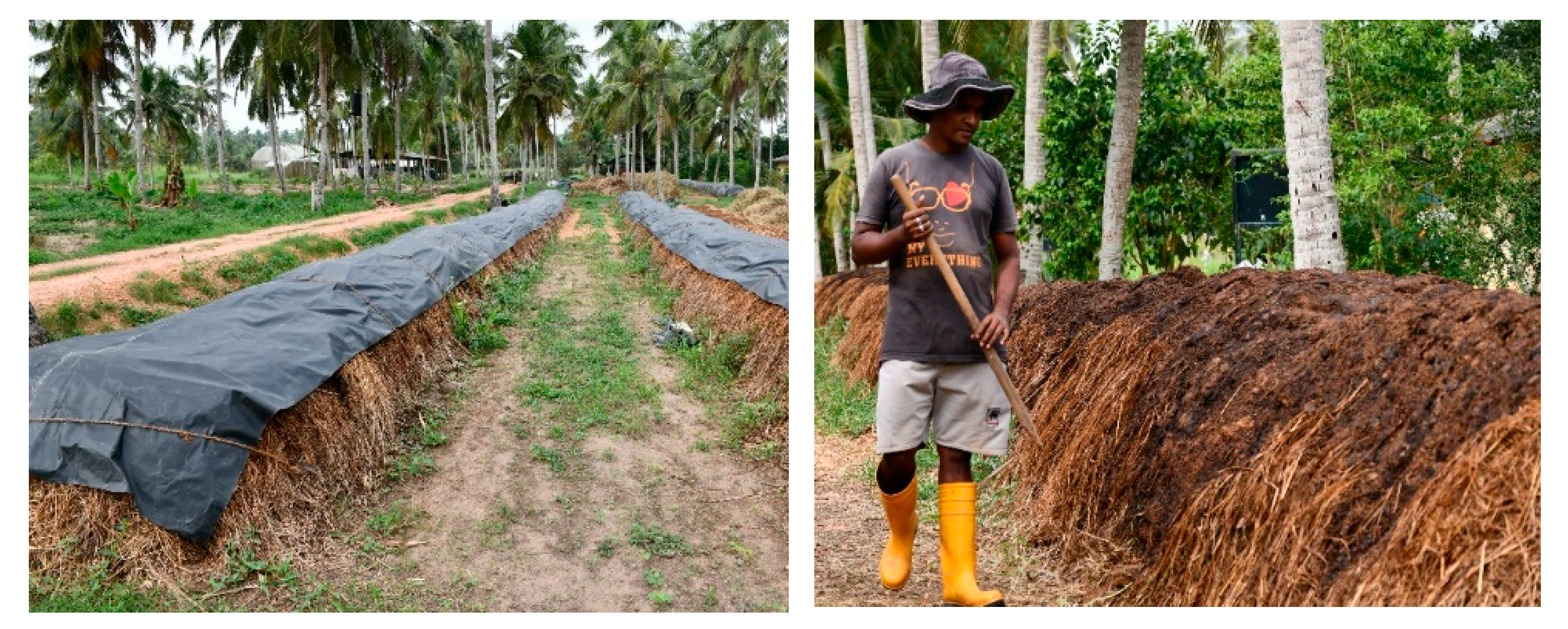

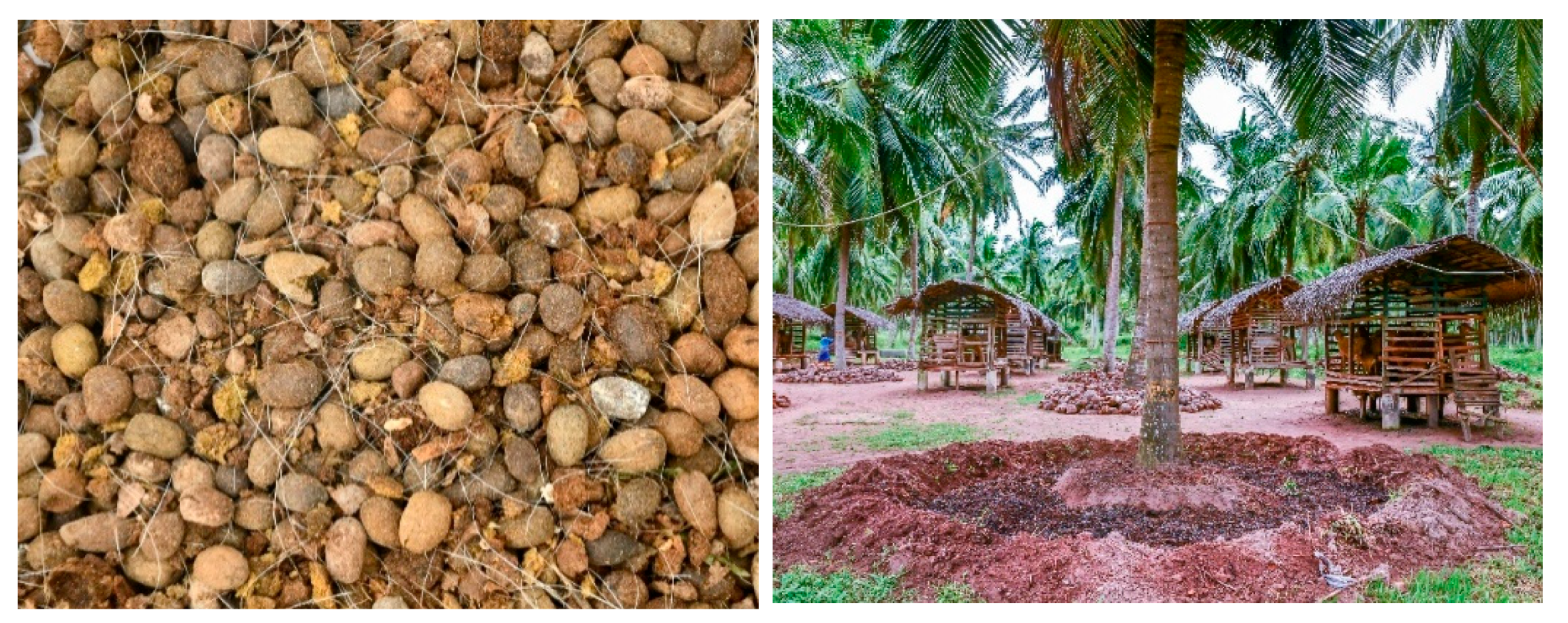

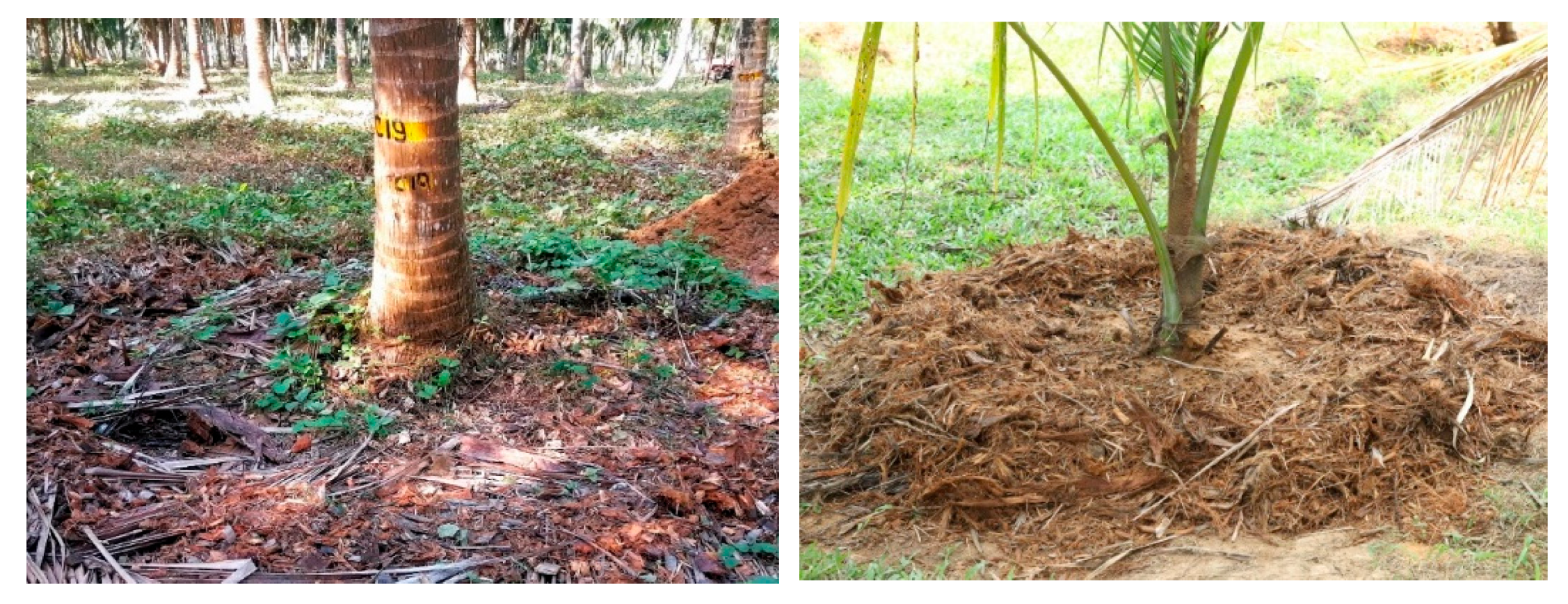
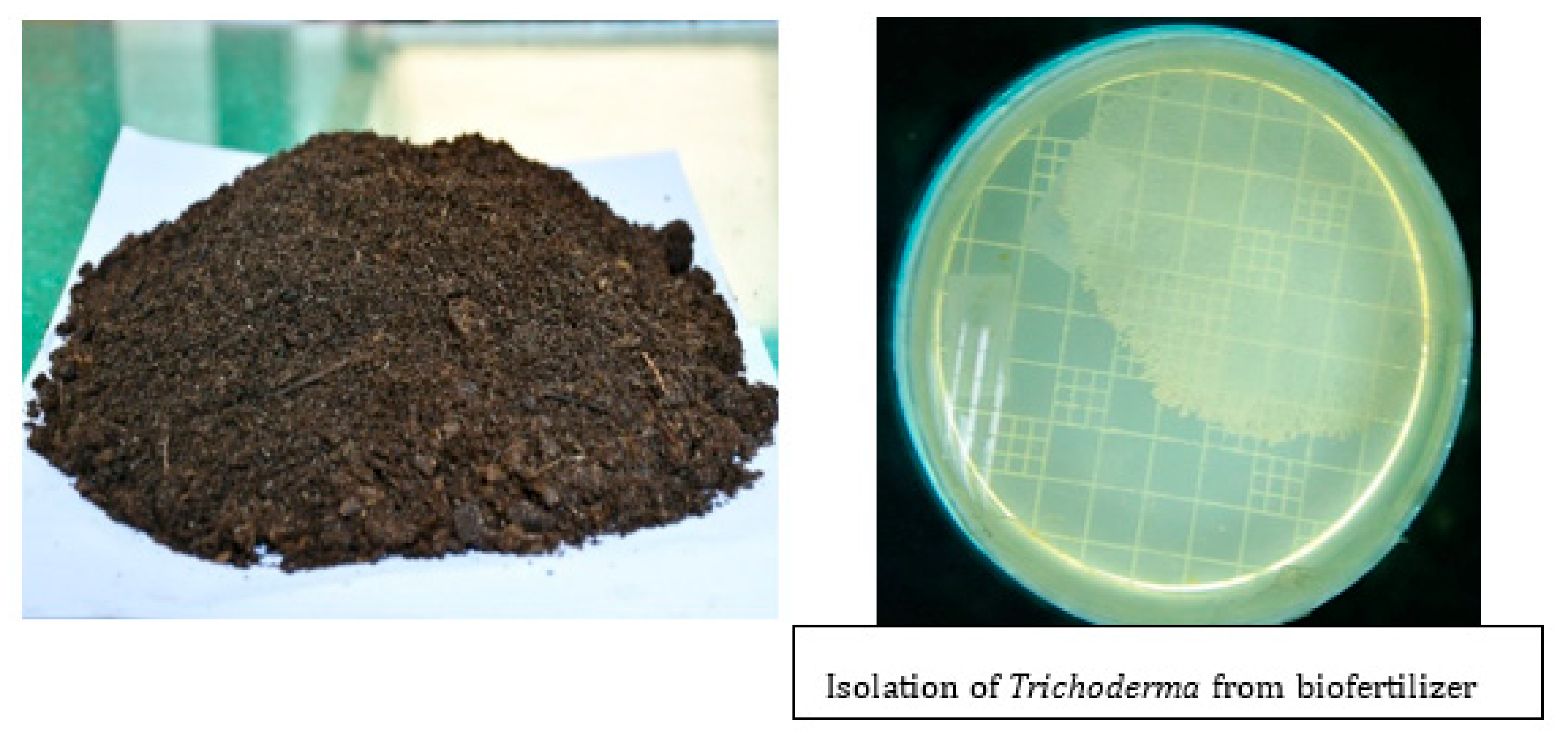
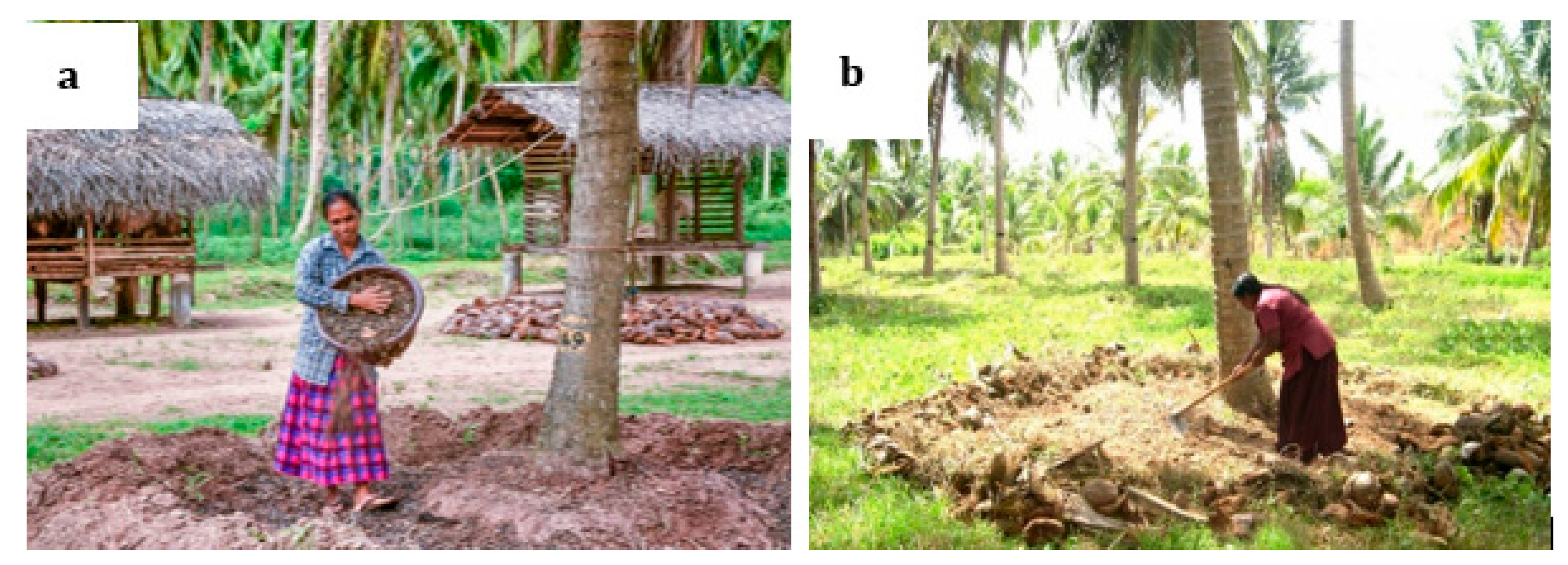
| Macronutrient % | Organic Source | Nitrogen (N) | Phosphorus (P) | Potassium (K) | Magnesium (Mg) | Calcium (Ca) |
| Goat manure | 2.2–3.4 | 0.3–0.7 | 1.5–2.5 | 0.4–0.8 | 1.5–2.4 | |
| Cattle manure | 1.2–1.9 | 0.2–0.5 | 0.5–1.1 | 0.5–0.6 | 1.3–1.8 | |
| Boiler litter | 2.0–2.3 | 0.6–1.0 | 1.7–2.0 | 0.5–0.6 | 1.0–4.9 | |
| Layer litter | 1.8–2.4 | 0.6–1.2 | 0.6–2.0 | 0.4–0.7 | 2.7–5.3 | |
| Pig dung | 1.0–2.0 | 0.6–0.9 | 0.4–0.9 | 0.4–0.6 | 1.0–1.5 | |
| Micronutrient ppm (mg/kg) | Organic Source | Iron (Fe) | Manganese (Mn) | Copper (Cu) | Zinc (Zn) | Boron (B) |
| Goat manure | 1449–2174 | 246–505 | 20–38 | 112–184 | 29–66 | |
| Cattle manure | 690–1518 | 167–389 | 24–40 | 128–183 | 13–30 | |
| Boiler litter | 723–1565 | 213–421 | 27–40 | 166–271 | 15–27 | |
| Layer litter | 1144–2215 | 287–450 | 22–38 | 182–329 | 2–12 | |
| Pig dung | 1020–1990 | 180–207 | 45–48 | 186–575 | 34–13 |
| Source | Time After Transplanting | ||||
|---|---|---|---|---|---|
| 6 Months | 1 Years | 2 Years | 3 Years | 4 Years up to Bearing (Every Year) | |
| Goat manure | 3 kg | 7 kg | 9 kg | 11 kg | 13 kg |
| (Moisture 20–30%) | |||||
| + | |||||
| Eppawala Rock Phosphate (in wet and intermediate zones) | 200 g | 450 g | 600 g | 750 g | 100 g |
| or | |||||
| Triple Super Phosphate | 85 g | 200 g | 270 g | 340 g | 420 g |
| (in dry zone) | |||||
| + | |||||
| Muriate of Potash | 50 g | 120 g | 150 g | 190 g | 225 g |
| + | |||||
| Dolamite | 250 g | 250 g | 250 g | 250 g | 250 g |
| Cattle manure | 5 kg | 12 kg | 16 kg | 20 kg | 25 kg |
| (Moisture 20–30%) | |||||
| + | |||||
| Eppawala Rock Phosphate (in wet and intermediate zones) | 200 g | 450 g | 600 g | 750 g | 1000 g |
| or | |||||
| Triple Super Phosphate | 85 g | 200 g | 270 g | 340 g | 420 g |
| (in dry zone) | |||||
| + | |||||
| Muriate of Potash | 30 g | 200 g | 250 g | 325 g | 400 g |
| + | |||||
| Dolamite | 250 g | 250 g | 250 g | 250 g | 250 g |
| Poultry manure (20–30%) | 5 kg | 12 kg | 16 kg | 20 kg | 25 kg |
| + | |||||
| Dolamite | 250 g | 250 g | 250 g | 250 g | 250 g |
| Gliricidia leaves | 5 kg | 12 kg | 16 kg | 20 kg | 25 kg |
| (Moisture 20–30%) | |||||
| + | |||||
| Eppawala Rock Phosphate (in wet and intermediate zones) | 275 g | 650 g | 825 g | 1100 g | 1350 g |
| or | |||||
| Triple Super Phosphate | 120 g | 285 g | 370 g | 470 g | 580 g |
| (in dry zone) | |||||
| + | |||||
| Muriate of Potash | 60 g | 150 g | 200 g | 250 g | 250 g |
| + | |||||
| Dolamite | 250 g | 250 g | 250 g | 250 g | 250 g |
| Treatments | Mean Nut Yield of Coconut (No. of Nuts/Palm/Year) | |||||
|---|---|---|---|---|---|---|
| 2016 | 2017 | 2018 | 2019 | 2020 | Mean | |
| 25% Organic + 75% RDF | 100 | 103 | 107 | 112 | 113 | 107 |
| 50% Organic + 50% RDF | 114 | 112 | 124 | 123 | 122 | 119 |
| 100% Organic | 109 | 112 | 113 | 114 | 117 | 113 |
| Control | 99 | 96 | 103 | 101 | 101 | 100 |
| Heavy Metal | Micro-Organism | Average Sorption Efficiency (%) |
|---|---|---|
| Chromium (Cr) | Bacillus circulans | 96 |
| Bacillus subtilis | 99.6 | |
| Saccharomyces cerevisiae | 95 | |
| Lead (Pb) | Cellulosimicrobium sp. | 99.3–84.6 |
| Bacillus firmus | 98.3 | |
| Staphylococcus | 82.6 | |
| Mercery (Hg) | Pseudomonas aeruginosa | 90 |
| Bacillus licheniformis | 70 | |
| Candidapara psilosis | 80 | |
| Copper (Cu) | Micrococcussp | 55 |
| Desulfovibrio desulfuricans | 90.3–90.1 | |
| Bacillu sfirmus | 74.9 |
Disclaimer/Publisher’s Note: The statements, opinions and data contained in all publications are solely those of the individual author(s) and contributor(s) and not of MDPI and/or the editor(s). MDPI and/or the editor(s) disclaim responsibility for any injury to people or property resulting from any ideas, methods, instructions or products referred to in the content. |
© 2025 by the authors. Licensee MDPI, Basel, Switzerland. This article is an open access article distributed under the terms and conditions of the Creative Commons Attribution (CC BY) license (https://creativecommons.org/licenses/by/4.0/).
Share and Cite
Atapattu, A.J.; Nuwarapaksha, T.D.; Udumann, S.S.; Dissanayaka, N.S. Integrating Organic Fertilizers in Coconut Farming: Best Practices and Application Techniques. Crops 2025, 5, 17. https://doi.org/10.3390/crops5020017
Atapattu AJ, Nuwarapaksha TD, Udumann SS, Dissanayaka NS. Integrating Organic Fertilizers in Coconut Farming: Best Practices and Application Techniques. Crops. 2025; 5(2):17. https://doi.org/10.3390/crops5020017
Chicago/Turabian StyleAtapattu, Anjana J., Tharindu D. Nuwarapaksha, Shashi S. Udumann, and Nuwandhya S. Dissanayaka. 2025. "Integrating Organic Fertilizers in Coconut Farming: Best Practices and Application Techniques" Crops 5, no. 2: 17. https://doi.org/10.3390/crops5020017
APA StyleAtapattu, A. J., Nuwarapaksha, T. D., Udumann, S. S., & Dissanayaka, N. S. (2025). Integrating Organic Fertilizers in Coconut Farming: Best Practices and Application Techniques. Crops, 5(2), 17. https://doi.org/10.3390/crops5020017







